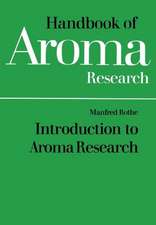Aromatic Plants: Basic and Applied Aspects: World Crops: Production, Utilization and Description, cartea 7
Editat de A. Koedam, M.S. Margaris, D. Vokouen Limba Engleză Paperback – 3 noi 2011
Preț: 388.34 lei
Nou
Puncte Express: 583
Preț estimativ în valută:
74.31€ • 77.78$ • 61.85£
74.31€ • 77.78$ • 61.85£
Carte tipărită la comandă
Livrare economică 31 martie-14 aprilie
Preluare comenzi: 021 569.72.76
Specificații
ISBN-13: 9789400976443
ISBN-10: 9400976445
Pagini: 300
Ilustrații: XI, 283 p.
Dimensiuni: 160 x 240 x 16 mm
Greutate: 0.42 kg
Ediția:Softcover reprint of the original 1st ed. 1982
Editura: SPRINGER NETHERLANDS
Colecția Springer
Seria World Crops: Production, Utilization and Description
Locul publicării:Dordrecht, Netherlands
ISBN-10: 9400976445
Pagini: 300
Ilustrații: XI, 283 p.
Dimensiuni: 160 x 240 x 16 mm
Greutate: 0.42 kg
Ediția:Softcover reprint of the original 1st ed. 1982
Editura: SPRINGER NETHERLANDS
Colecția Springer
Seria World Crops: Production, Utilization and Description
Locul publicării:Dordrecht, Netherlands
Public țintă
ResearchCuprins
1 — Anatomy and Morphology.- - Ultrastructure of the essential oil secretion in glandular scales of Origanum dictamnus L. leaves.- - Leaf morphology of Thymus capitatus (Labiatae) by scanning electron microscopy.- - Inula hairs — Structure, ultrastructure and secretion.- - Pollen morphology of the genus Origanum L. and allied genera.- 2 — Ecology and Distribution.- - Volatile oils as allelopathic agents.- - Artemisia tridentata monoterpenoid effect on ruminant digestion and forage selection.- - Productivity of aromatic plants: climatic models.- - A taxonomic revision of Sideritis L. section Empedoclia (Rafin.) Bentham (Labiatae) in Greece.- 3 — Chemotaxonomy.- - Morphological, cytological and chemical investigations of Mentha spicata L. in Greece.- - Distribution of flavonoids as chemotaxonomic markers in the genus Origanum L. and related genera in Labiatae.- - New chemical markers within Artemisia (Compositae-Anthemidae).- - Chemical investigations of essential oils of Umbellifers.- 4 — Analysis and Composition.- - 13C-NMR analysis of essential oils.- - Qualitative evaluation of aromatic herbs by direct space (GC)2 analysis. Application of the method and comparison with the traditional analysis of essential oils.- - The chemical composition of the essential oil obtained from Satureja kitaibelii Wierzb. ap. Heuff..- - The essential oil from Thymus praecox ssp. arcticus.- - Atractylodes lancea DC. (Compositae). Contribution on the constituents of the essential oil..- - Chemotaxonomy of the Greek species of Sideritis. I. Components of the volatile fraction of Sideritis raeseri ssp. raeseri.- - The terpenes of the essential oil of myrrh.- 5 — Production and Application.- - The influence of some distillation conditions on essential oil composition.- - Variationsin yield parameters in a wild population of Origanum vulgare.- - The production of aromatic plants in the Pancalieri area.- - Some potentially important indigenous aromatic plants from the eastern seaboard areas of Southern Africa.- - Labiatae as medicinal plants in Israel.- - New pharmacologically important flavonoids of Thymus vulgaris.- Plant Systematic Index.- Chemical Index.





































